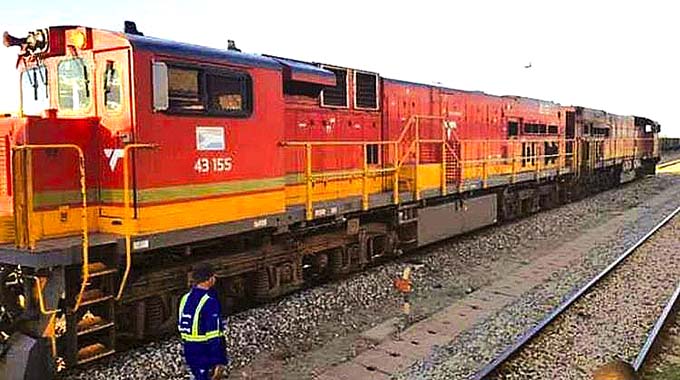Dilapidated railways system takes toll on country’s exports
Zimbabwe’s mineral wealth is locked away by a crumbling national railway system that is severely limiting the country’s ability to exploit offshore markets, particularly for coal and coke due to high inland transportation costs, Gumisai Nenzou, the marketing manager for the Minerals Marketing Corporation of Zimbabwe (MMCZ) has said.
While Zimbabwe previously exported coke and coal products to regional markers, particularly to copper smelters in the Democratic Republic of Congo (DRC) and Zambia, the market landscape has shifted.
The emergence of new producers in the region has led to excess supply, making it difficult for Zimbabwe to compete on that front.
On the domestic market, a recent surge in investment, with roughly 15 new ventures focusing on coal and coal value-added products, has led to an expanded domestic production capacity.
The increase has created an excess capacity that the already saturated regional market cannot absorb.
Nenzou said the domestic production boom was exacerbating the bottlenecks at the export level due to the crippling state of the rail system.
“It’s a worrisome trend and this has been one of the major challenges of developing new markets,” said Nenzou while addressing journalists at a recent workshop. The workshop, organised by MMCZ, was aimed at familiarising journalists from various media houses with the corporation’s operations and global mineral marketing dynamics.
MMCZ is a state-owned minerals marketing agency responsible for marketing all minerals except gold and silver.
Maritime regulations
Nenzou further highlighted the broader challenges of overcoming logistical hurdles to reach new offshore buyers.
He said relying on road transportation presented a significant challenge in meeting strict maritime regulations.
Tight timeframes for loading vessels are difficult to achieve with road haulage, potentially causing exporters to miss loading targets. This can result in hefty charges for “unoccupied vessel space,” further squeezing profit margins for the exporters.
“The road (transportation system) makes us less competitive in terms of logistics,” said Nenzou.
“To expand into the offshore markets, we need to reduce inland costs.”
The NRZ network is characterised by outdated and sinking tracks, signaling systems and locomotives.
This leads to slow travel times, frequent breakdowns, and a higher risk of derailments. Underinvestment in maintenance and upgrades has also left the NRZ struggling to keep up with basic operations.
The combination of these factors have significantly reduced the NRZ’s capacity to handle large volumes of freight efficiently and made transporting minerals to ports for export slow and expensive.
NRZ’s inefficiencies not only limit mineral exports but also force companies to rely on road transportation, which is more expensive and damages roads designed for lighter traffic.
“The ailing state of our railway system, coupled with a lack of investment, has significantly crippled the NRZ’s ability to handle large volumes of freight efficiently,” Harare-based economic analyst Carlos Tadya said.
“This translates to slow and expensive transportation of minerals to ports, hindering our potential. Exporting minerals becomes sluggish and expensive due to the logistical challenges posed by our deteriorating rail infrastructure.”
The Government has previously attempted to secure partnerships with international companies to modernise the NRZ infrastructure.
Despite expressions of interest from several contenders, including a joint venture of Transnet and Diaspora Infrastructure Development Group (DIDG) that offered a potential investment of US$400 million in August 2017, no concrete agreements have materialised.
In 2023, the NRZ transported 2,2 million tonnes of freight, primarily high-value minerals like lithium and ferrochrome due to their more favourable export economics compared to coal. This year, the freight volumes are expected to increase by 17 percent, NRZ spokesperson Andrew Kanambura said recently
Despite this uptick, the 2,7 million tonnes target remains a far cry from the NRZ’s past performance. In its prime, the parastatal routinely handled 18 million tonnes of freight annually, employing a workforce of 20 000.
Despite a successful trial shipment of 20 000 tonnes of coal to China’s cement industry in November 2022, high transportation costs continue to hinder large-scale exports.
Global coal consumption saw mixed trends in 2023. The US and EU witnessed a significant decrease, likely due to a shift away from gas after the Russia-Ukraine war.
However, China and India bucked the trend with an increase in coal consumption. China, a dominant player in the global coal market, saw a rise in coal-fired power generation, likely due to temporary factors like drought and economic rebound.
The International Energy Agency (IEA) expects China’s coal use for power generation to decline in the coming years as renewable energy sources gain momentum, highlighting a potential shift towards a cleaner energy future.
Strong demand hampered by rail woes
While the Zimbabwe Coal Producers Association (ZCPA) reported strong demand from China and Europe, at least in short to medium terms, the markets remain out of reach due to the logistical challenges posed by the country’s ailing railway system. The coal for the trial shipment was transported through the Mozambican port of Beira.
The ZCPA has previously said the limited capacity of NRZ, coupled with high rail costs was making exports of the commodity unviable.
Some coal mining companies are now forced to scale back production due to a lack of viable export options.
Last week, Hwange Colliery Company Limited said it was considering stopping underground mining for the next six months to stop losing mined coal through spontaneous combustion “as production is way more than sales.”
“The quantity of mined coal is deemed sufficient to meet the operating needs of the company,” Hwange administrator Munashe Shava said in the company’s trading for the third quarter ended September 30, 2023.
He said the decision came after the company stockpiled a significant amount of coal, with sales failing to keep pace with the recent surge in production.
Similarly, many mining companies are burdened with stockpiles of coal and coking coal that they cannot offload due to limited absorption by local and regional markets.
0businessweekly











